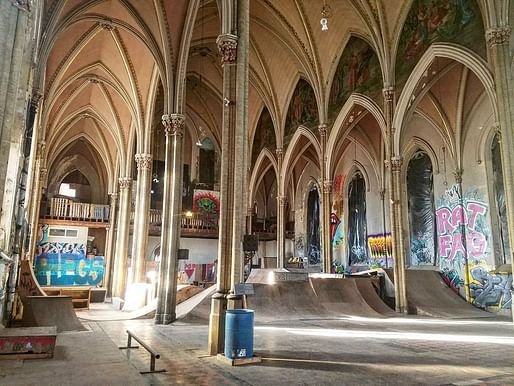

A four-alarm fire late Wednesday engulfed a towering historic church that had been converted into an indoor skatepark north of downtown St. Louis. No injuries were reported in the blaze at S, near Hogan and North Market streets. The cause of the fire remained under investigation as of 3:30 p.m. Thursday. — St. Louis Post-Dispatch
The fire is believed to have started in the church rectory before it spread to where the skatepark is. The German Gothic church at the St. Liborius Parish Complex in the city’s St. Louis Place neighborhood was originally constructed in 1889. The building was declared a city landmark in 1975 and listed on the National Register of Historic Places in 1979 before it closed in 1992. The current owner of the church, Dave Blum, purchased it in 2012, which was followed by its renovation into a skate park named Sk8 Liborius in 2016.
Video courtesy SK8 Liborius/YouTube
The former church had become a sanctuary for St. Louis’ skater community as one of the few dedicated skating locations in the city. Skate ramps, notably a 40-foot miniature ramp in the center, graffiti, and murals replaced what were once pews.
It remains unclear what the cause of the blaze was. Blum is working with fire investigators to learn more. A fundraiser to conduct the site’s upkeep and support the efforts of SK8 Liborius, which includes making the church a venue for not just skating but also a site for art, education, and mentorship, has existed for years and is still accepting donations.
6 Comments
Seems like converting the church into a library would make more sense. What they have done to the structure is basically obscene.
Imagine what those priests did inside the place.
Obscene is what that place represented prior to the sweet restoration skate park. Sad to see this conversion project go. We need more skate parks and fewer churches.
Church of Skaten
National Catholic Reporter gives a brief, polite review of St. Liborius—this is an attractive complex—and the general problem in St. Louis and throughout: distinctive religious buildings in peril because of declining attendance and/or the move of the congregation from urban centers to the suburbs, along with increasing costs of maintenance.
The first option is to find another religious group to take it over; that's the easiest. The second is, if it can't be salvaged because of market demand and the congregation can't afford to continue paying for upkeep, you sell the land for another use, and that happens a fair amount of the time. The third is converting it to a community center or public space. They're great, but expensive. And the fourth is converting it to housing.
https://www.ncronline.org/news/st-louis-former-houses-worship-are-retooled-meet-citys-needs
Years from now, historians might offer another interpretation.
Vandals sacking Rome (whose excesses are debated), Karl Briullov.
The Briullov itself is intriguing—and disturbing. Note the Black threatening the (awfully) white women, at the center. The Vandals—Germanic but swarthy here—invaded North Africa and may have enlisted/pushed Moors into their service (and may have enslaved them).
Block this user
Are you sure you want to block this user and hide all related comments throughout the site?
Archinect
This is your first comment on Archinect. Your comment will be visible once approved.